Germany and Berlin after WW2 experienced a period of profound transformation and reconstruction.
The nation, once the main aggressor of the war, faced the consequences of defeat, which included territorial losses, economic deprivation and a division into occupation zones managed by the Allied forces.
Berlin, the capital, lay in ruins, a stark landscape of destruction with countless buildings demolished and its population displaced.
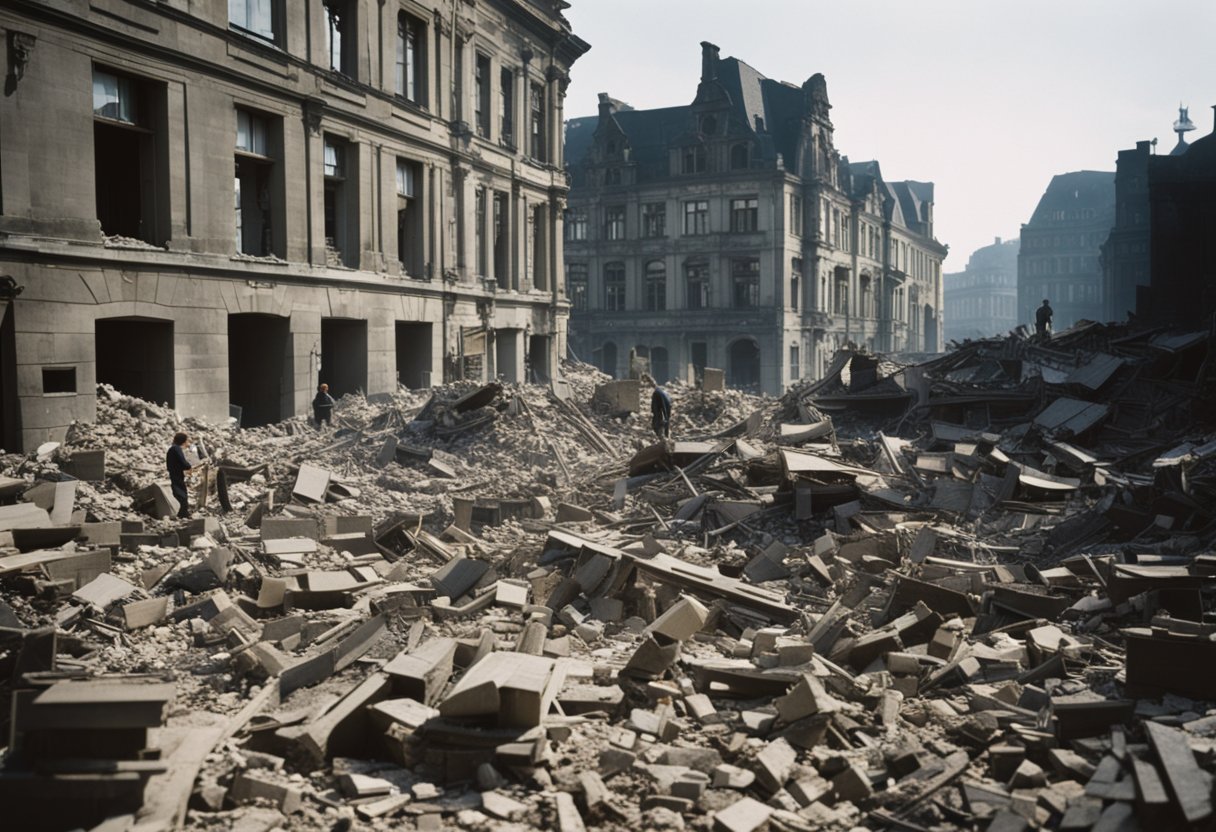
The end of World War II marked the beginning of a divided Berlin. The city, symbolically and physically, represented the epicenter of the Cold War tensions that followed the cessation of hostilities in 1945. By 1961,
Berlin became even more divided when the East German government erected the Berlin Wall, crystalizing the separation between East and West Berlin. This division remained a powerful emblem of the ideological divide that characterized the post-war period.
Germany’s road to recovery was arduous and fraught with challenges. The Allied bombing campaigns during the war left millions homeless, exacerbating the struggle to rebuild.
In response to the devastation, Germany underwent a period of intensive rebuilding efforts known as the Wirtschaftswunder or “economic miracle,” which would, over time, see both West Germany and Berlin rise from the ashes of war to become centers of political and economic significance in Europe.
Germany and Berlin After WW2
Germany’s Surrender and Immediate Aftermath
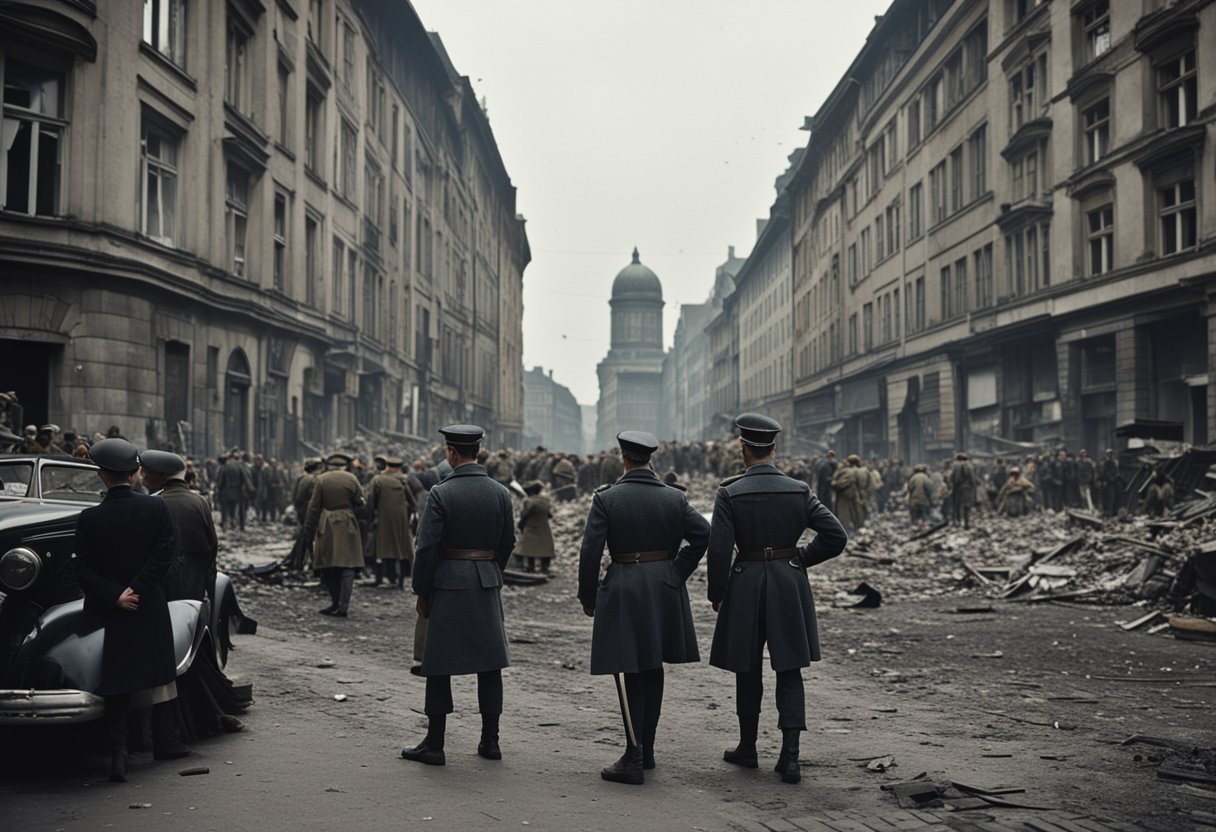
Germany faced a complete overhaul of its political, social, and physical structures following its unconditional surrender on May 7, 1945, marking the end of World War II in Europe.
Unconditional Surrender and Occupation Zones
Germany surrendered unconditionally to the Allied Powers, which included the United States, Soviet Union, United Kingdom, and France. This act concluded the conflict in Europe but thrust Germany into an uncertain future as it lay in ruins.
The country was divided into four occupation zones, each controlled by one of these powers. This geographical split would lay the foundations for the future political landscape of both Germany and particularly Berlin, which, as the capital, was also divided into four segments, despite being situated deep within the Soviet zone.
Potsdam and Yalta Conferences
Two pivotal conferences shaped the post-war governance of Germany. The Yalta Conference, held in February 1945 before the war’s end, saw the Allied Powers agree on dividing Germany into occupation zones. Each of these zones would be administered by an Allied military command.
The Potsdam Conference, which took place after Germany’s surrender between July and August 1945, addressed the necessary steps to denazify, demilitarize, decentralize, and democratize the country. Decisions made at Potsdam also set the stage for the eventual ideological divide between the Eastern Bloc and the Western Powers, contributing to the origins of the Cold War.
Political and Geographical Division
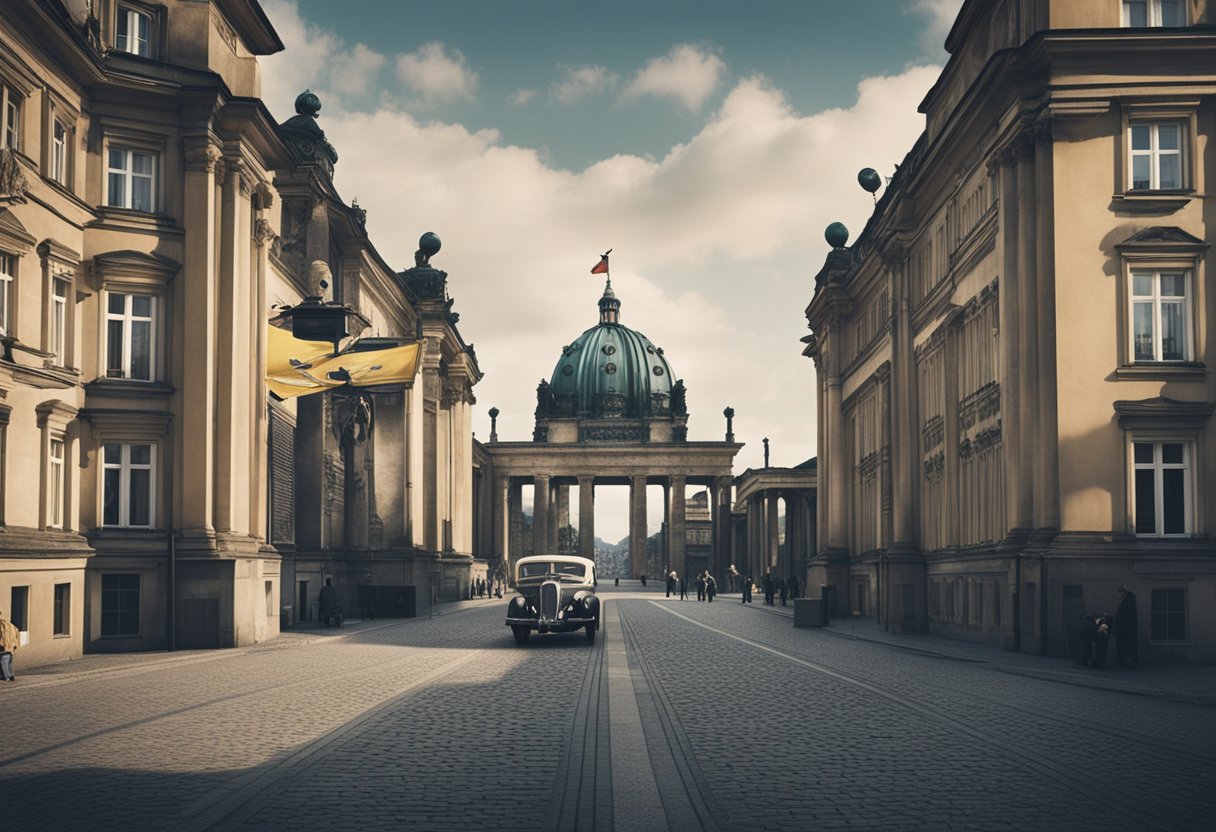
In the wake of World War II, Germany and its capital, Berlin, faced significant territorial changes and the establishment of distinct political regimes influenced by the Allied powers.
Formation of East and West Germany
Germany saw its division into two separate states by 1949, with the establishment of the Federal Republic of Germany (West Germany) and the German Democratic Republic (East Germany).
This division was deeply influenced by the differing ideologies of the occupying forces — the United States, British, and French in the west, and the Soviet Union in the east. The Allied Control Council, responsible for administering Germany post-war, had initially governed the country as a single unit divided into four occupation zones.
However, political disagreements led to the formation of two German states, each with its own government, policies, and international affiliations.
Berlin’s Partition and the Berlin Wall
Berlin, despite being situated within the Soviet zone, was similarly divided into occupation sectors. These sectors eventually coalesced into East Berlin and West Berlin, reflections of the larger division of Germany.
Tensions between the Soviet Union and the Western Allies resulted in events such as the Berlin Blockade and subsequent Berlin Airlift in the late 1940s. The most iconic symbol of the Cold War, the Berlin Wall, was erected in 1961.
It physically separated East and West Berlin, slicing through neighborhoods and even separating families. The Brandenburg Gate, once a symbol of a unified Berlin, became a poignant symbol of division as it stood just inside the partitioned city’s Soviet sector.
Social and Economic Reconstruction
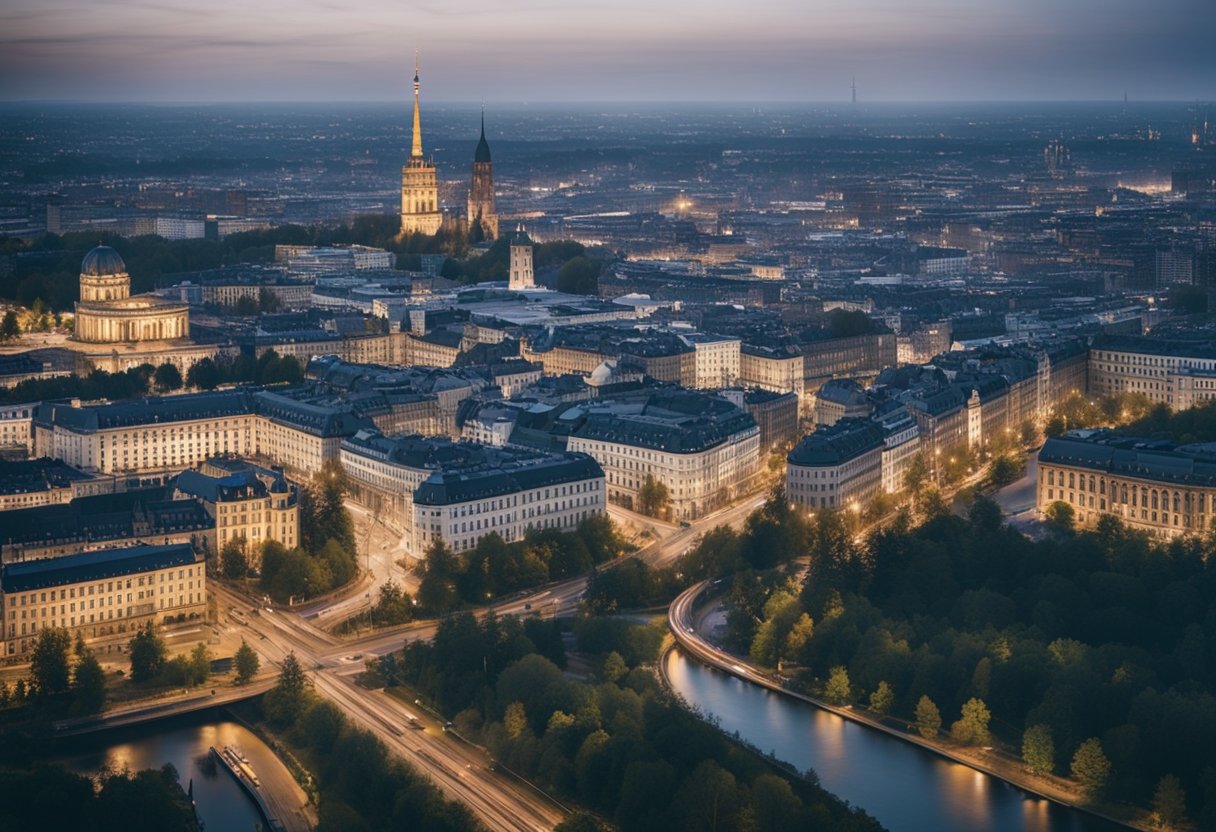
After World War II, Germany faced the monumental tasks of social rehabilitation and economic revival. The processes of denazification and democratization aimed to dismantle the remnants of the National Socialist regime, while economic policies sought to address rampant unemployment and inflation.
Denazification and Democratization
Denazification was initiated to purge German society, government, and culture of Nazi ideology. It involved removing Nazi sympathizers from positions of influence and prosecuting key figures for war crimes.
The Allies, particularly the American forces, sought to facilitate democratization by reestablishing political parties and fostering a political climate that could support a stable democratic state.
Economic Policies and the Marshall Plan
In the wake of WWII, Germany’s economy was in ruins, with a staggering unemployment rate and a currency that was virtually worthless.
Initially, the Morgenthau Plan had aimed to deindustrialize Germany to prevent future military aggression, but it soon gave way to the more constructive approach of the Marshall Plan.
The Marshall Plan was critical for economic recovery; it provided the financial aid and framework necessary to rebuild infrastructure, stimulate industrial production, and stabilize the economy.
Life in Divided Germany
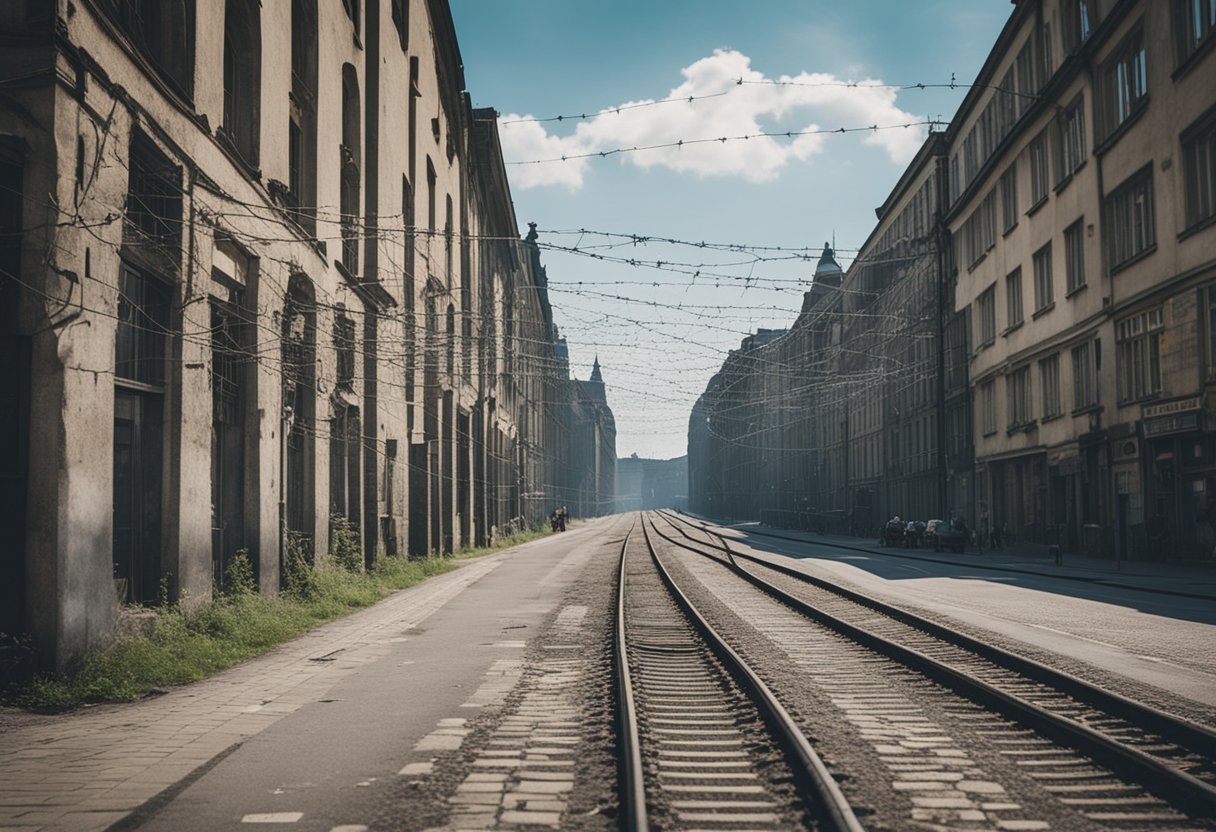
Following World War II, Germany and its capital, Berlin, experienced significant transitions. Both were split into Eastern and Western regions, greatly impacting the life of civilians who found themselves on either side of the divide.
Living Conditions in East and West Germany
East Germany, officially known as the German Democratic Republic (GDR), faced heavy Soviet influence leading to a socialist-style government. The population endured restricted freedoms, with the state implementing stringent surveillance.
Rationing was a part of life, and consumer goods were often scarce. In contrast, West Germany, or the Federal Republic of Germany (FRG), thrived through economic aid like the Marshall Plan, fostering a more prosperous economy where civilians could enjoy a higher standard of living.
This stark contrast in living conditions led many East Germans to seek a better life in the West, contributing to population movements between the two sides.
Housing
- East Germany: Characterized by prefabricated concrete buildings; long waits for housing.
- West Germany: Quicker rebuilding efforts; better quality and variety of housing.
Employment
- East Germany: State-controlled economy presented limited career paths; full employment was typical but often underproductive.
- West Germany: A market economy provided more diverse and rewarding job opportunities.
Culture and Society in the Shadow of the Wall
The erection of the Berlin Wall in 1961 solidified the division, not just physically but also culturally. West Berlin became an island of western culture and freedom within the communist East. This fostered a unique, vibrant culture that drew artists and intellectuals from around the world.
On the other side, East Berlin still maintained a rich cultural life, but one that existed under the watchful eye of the state. Cultural expression was often harnessed to serve socialist propaganda, and censorship was commonplace, limiting the spectrum of artistic and intellectual discourse.
Cultural Institutions
- East Germany: State-run theaters, book publishers, and film industry.
- West Germany: A broader range of influences, with significant American cultural import during the Cold War.
Society
- East Germany: Strong community organizations, yet with intense state oversight.
- West Germany: More individualistic society with greater personal freedoms.
In summary, life in divided Germany reflected a broader global struggle during the Cold War era, with stark differences between socialist East and capitalist West. These differences permeated every aspect of daily life, from employment and housing to cultural and social expressions.
International Relations and Cold War Dynamics

Following World War II, Germany and its capital, Berlin, became the focal points for international tensions and the emergence of the Cold War. The city and the country were divided among the victors, leading to a bifurcation that exemplified the escalating Cold War politics.
Alliance Systems and Military Presence
Post-World War II, Germany was divided into four occupational zones, controlled by the Soviet Union, the United States, Britain, and France. This division sowed the seeds for the emergence of two distinct German states by 1949: the Federal Republic of Germany (FRG) in the west and the German Democratic Republic (GDR) in the east.
Berlin, located wholly within Soviet-controlled territory, was similarly divided into West and East Berlin. The Western Allies, including the United States, Britain, and France, and later NATO members, maintained a military presence in West Germany and West Berlin. Conversely, East Germany and East Berlin were under the influence of the Soviet Union and the Warsaw Pact.
The division of Berlin into occupation zones was physically manifested when Winston Churchill coined the term “Iron Curtain” during his 1946 speech.
In the years following, both the Soviet Union led by Joseph Stalin, and Western powers, spearheaded by leaders like Harry Truman and Franklin D. Roosevelt, fortified their respective alliance systems, bolstering their military and ideological presence in their controlled zones.
Espionage and Cross-Border Tensions
Espionage became a key aspect of the Cold War as both the West and the Soviet Union sought to gather intelligence and undermine each other’s influence in Europe.
Berlin turned into an espionage hotspot, with both sides conducting covert activities to ascertain the other’s capabilities and intentions. The city, symbolizing the ideological division of the world, witnessed frequent cloak-and-dagger operations that stoked further distrust between the powers.
Cross-border tensions manifested prominently in Berlin. The Berlin Blockade (1948–1949), initiated by the Soviet Union in an attempt to gain control over the entire city, led to the Berlin Airlift, where the Western Allies supplied West Berlin by air.
While the blockade ultimately failed, it epitomized the dramatic standoffs that would characterize the Cold War era. These tensions continued throughout the period, culminating in the construction of the Berlin Wall in 1961, which stood as a concrete representation of a city — and a world — divided.
The Path to German Reunification
After World War II, Germany was divided into occupation zones, leading to the establishment of two separate states: the Federal Republic of Germany (FRG, or West Germany) and the German Democratic Republic (GDR, or East Germany).
The journey to German reunification was marked by a series of pivotal events and political changes that culminated in the unification of these two states in 1990.
Fall of the Berlin Wall and Political Changes
The Berlin Wall was the physical symbol and literal barrier between East and West Germany. Constructed in 1961, it was a manifestation of Cold War divisions. However, the late 1980s saw a wave of change sweep across Eastern Europe.
Reformist policies in the Soviet Union under Mikhail Gorbachev led to a relaxation of control over the communist bloc. Significant events in 1989, including mass protests and political reforms, weakened the GDR’s government.
On November 9, 1989, the fall of the Berlin Wall became a symbol of the end of the Cold War and a prelude to German reunification. As border restrictions were lifted, jubilant crowds gathered to celebrate and chip away at the Wall, signaling the beginning of the end for the divided Germany.
Treaty on the Final Settlement
The process of unification was formalized through diplomacy. The Treaty on the Final Settlement with respect to Germany, often referred to as the Two Plus Four Agreement, involved the two German states and the four Allied powers (the United States, the Soviet Union, the United Kingdom, and France).
The treaty addressed key issues such as the borders of Germany, the status of German armed forces, and the withdrawal of Allied troops. This treaty laid the groundwork for the reunification of Germany, formally achieved on October 3, 1990.
The Treaty on the Final Settlement resolved the final legal issues concerning Germany’s sovereignty, and it marked the end of post-war division. Germany became a fully sovereign state within its pre-war borders, barring any further territorial claims.
Legacy and Memorials
After the fall of Nazi Germany and the end of WWII, Berlin became a symbol of both devastating destruction and eventual rebirth, with memorials and landmarks serving as poignant reminders of the past and important educational resources.
Remembrance and Education
Berlin and Germany faced a difficult path of reconstruction after the war. The Brandenburg Gate, heavily damaged, stood as a testament to the city’s resilience.
It was not simply the physical rebuilding that mattered but also addressing the psychological and historical scars left by the war. The Reichstag, another iconic building, underwent reconstruction, including the addition of the famous glass dome, symbolizing transparency and democracy.
Many sites associated with the Nazi regime, like Gestapo headquarters, have been transformed into memorials. These sites now serve as vital places of education about the horrors of the Holocaust and the dangers of totalitarianism, working alongside initiatives that promote remembrance and historical understanding.
Tourism and Landmarks
The Berlin Wall, constructed post-war, stands as a stark reminder of the city’s divided past and is a focal point for tourists seeking to understand the Cold War era. While most of the wall has been dismantled, preserved sections are covered with graffiti, a visual narrative of Berlin’s struggle for freedom.
Other landmarks such as the Kaiser Wilhelm Memorial Church, left in ruins as a reminder of the destruction, draw visitors globally, maintaining Berlin’s legacy as a city of historical significance. These sites contribute significantly to Berlin’s identity and its role as a hub for tourism, with individuals from around the world coming to learn about Berlin’s turbulent 20th-century history.
Frequently Asked Questions
This section addresses some of the most common inquiries regarding the state of Germany and Berlin in the wake of World War 2.
Why was Germany divided after the conclusion of World War 2?
Germany was divided after the war due to the Allied powers’ decision to partition the defeated nation to reduce the likelihood of future conflicts and as a result of diverging political ideologies. The country was split into East and West, with the Soviet Union occupying the east and the other Allies the west.
What events led to the division of Berlin following World War 2?
Berlin, although located within the Soviet-occupied zone, was itself subdivided into four sectors controlled by the United States, the United Kingdom, France, and the Soviet Union, which eventually led to its physical and ideological split, culminating in the construction of the Berlin Wall.
How did life in Germany change in the years immediately following the end of World War 2?
In the years after World War 2, Germany faced extensive changes ranging from political reorganization, economic restructuring through the Marshall Plan, to the seismic social shifts as the population dealt with the consequences of the war and occupation.
What were the major consequences faced by Germany as a result of World War 2?
Germany faced significant territorial losses, had to pay reparations, and underwent demilitarization and denazification. The economic infrastructure was devastated, leading to currency reform and reconstruction efforts.
How long did the reconstruction of Germany take after the cessation of World War 2 hostilities?
The reconstruction of Germany, particularly the rebuilding of cities and industries, took several years, with the impact of the Marshall Plan being felt in the late 1940s and the economy improving significantly by the 1950s.
What significant changes occurred in Berlin following the dismantling of the Berlin Wall?
Following the dismantling of the Berlin Wall in 1989, Berlin experienced a renaissance, unifying its divided sectors and undergoing considerable redevelopment. It led to a cultural revival and the re-establishment of Berlin as the capital of a reunified Germany.